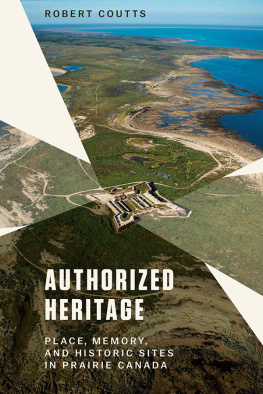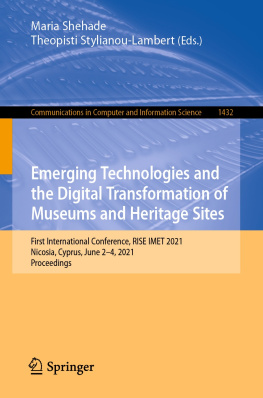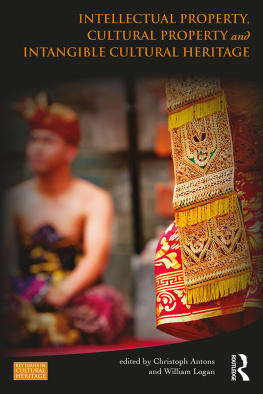Authorized Heritage
Authorized Heritage
Place, Memory, and Historic Sites in Prairie Canada
Robert Coutts
Authorized Heritage: Place, Memory, and Historic Sites in Prairie Canada
Robert Coutts 2021
25 24 23 22 21 1 2 3 4 5
All rights reserved. No part of this publication may be reproduced or transmitted in any form or by any means, or stored in a database and retrieval system in Canada, without the prior written permission of the publisher, or, in the case of photocopying or any other reprograpic copying, a licence from Access Copyright, www.accesscopyright.ca, 1-800-893-5777.
University of Manitoba Press
Winnipeg, Manitoba, Canada
Treaty 1 Territory
uofmpress.ca
Cataloguing data available from Library and Archives Canada
ISBN 978-0-88755-926-6 (paper)
ISBN 978-0-88755-930-3 (pdf)
ISBN 978-0-88755-928-0 (epub)
ISBN 978-0-88755-932-7 (bound)
Interior design by Karen Armstrong
Cover design by Marvin Harder
Cover image: Prince of Wales Fort, Churchill,
courtesy of Parks Canada
Printed in Canada
This book has been published with the help of a grant from the Federation for the Humanities and Social Sciences, through the Awards to Scholarly Publications Program, using funds provided by the Social Sciences and Humanities Research Council of Canada.
The University of Manitoba Press acknowledges the financial support for its publication program provided by the Government of Canada through the Canada Book Fund, the Canada Council for the Arts, the Manitoba Department of Sport, Culture, and Heritage, the Manitoba Arts Council, and the Manitoba Book Publishing Tax Credit.
To my wife, Catherine, who can see from a great distance what I cannot see close.
And to Margot and Hugh.
Contents
Introduction: Landscapes of Memory in Prairie Canada
Chapter 1 - Memory Hooks: Commemorating Indigenous Cultural Landscapes
Chapter 2 - National Dreams: Commemorating the Fur Trade in Manitoba
Chapter 3 - We Came. We Toiled. God Blessed: Settler Colonialism and Constructing Authenticity
Chapter 4 - Contested Space: Commemorating Indigenous Places of Resistance
Chapter 5 - Heritage Place: The Function of Modernity, Gender, and Sexuality
Conclusion: History, Memory, and the Heritage Discourse
Acknowledgements
Notes
Bibliography
Index
Map 1. Heritage places discussed in this book.
Introduction
Landscapes of Memory in Prairie Canada
Landscapes are culture before they are nature; constructs of the imagination projected onto wood and water and rock.
Simon Schama, Landscape and Memory
Landscape as culture. It is a concept that at first glance seems peculiar. Upon reflection, however, we realize that our Western view of landscape is the result of shared values and shared culture, a culture assembled from a rich accumulation of myths, folklores, events, and memories. Such landscapes of memory are cultural memories, and we all experience place and memory in different ways. One of my own encounters came from historical interest rather than personal familiarity. It was in August of 1983 that I found myself with a small group of people in a boat heading to Hudson Bay. We were travelling on the Hayes River in northern Manitoba, bound for York Factory, the once great trading post and entrept of the Hudsons Bay Company. Leaving from the junction of the Fox and Hayes rivers about 120 kilometres southwest of Hudson Bay, we travelled the river in the warm summer sunshine as the topography of the lowlands became flatter, the riverbank grew steeper, and the fir trees appeared smaller and stunted, bent low by the winter winds off the bay. We travelled for hours and the wilderness around us seemed interminable. But as the river grew wider, a last bend revealed a remarkable sight; the massive, gleaming white Depot Building of York Factory appeared as if an apparition, its presence startling in the vastness of the surrounding wilderness. I had read much about this place and its history, but I found it exhilarating to finally experience it in person.
I thought about the Indigenous peoples who witnessed this same sight over centuries, though they journeyed from far greater distances and of course without the modern motorized transport that made our trip so comfortable. Although it is colonial space (even if I had not thought of it that way in 1983), York Factory remains a place of becoming, of memory both local and beyond, and a representation of place and community that embodies the persistence of the past in the present. Whether the most respectable place in the territory to another, less generous writer, York today remains a place of cultural memory that is central to the traditions of the Muskego Cree community in northern Manitoba. But unlike York Factory and so many other striking and meaningful locations in the West, not all places of significance are necessarily monumental or old or even aesthetically pleasing. They are places that do not have inherent value or convey a meaning that is innate. For those who have lived in or near these landscapes, or for those who might come to a particular place with a different appreciation, it is historical referenceassociative, personal, or imaginedthat makes them physically symbolic and meaningful.

In her 2006 book Uses of Heritage, the Australian writer and archaeologist Laurajane Smith described her meeting with a group of Indigenous women from the Waanyi community on the banks of the Gregory River in Boodjamulla National Park in northern Queensland. The women, according to Smith, had come from some distance away to meet and fish at this traditional Indigenous site. In attempting to, as she writes, pester people with maps, site recording forms and tape measures, Smith soon realized that for these Waanyi women, the act of fishing was more than simply catching dinner; it was an opportunity to savour simply being in a place that was important to them. It was, as she comments, heritage work being in this place, renewing memories and sharing experiences with friends and family members to strengthen present and future social and family relations.
My own experience with community memory and the meaning and significance of place was somewhat similar to Smiths. A number of trips after my first visit to York Factory in 1983, while conducting ethnohistorical research at York Factory in northern Manitoba as a historian with Parks Canada in 2002, I met with a number of Muskego Cree Elders who had flown there for a reunion and with whom I had arranged informal interviews. The conversation was relaxed as we talked about the history of the place and the Elders experiences growing up at York. In these conversations I noticed that their memories often began with some reference to place, to a geographical entity or location that became the reference point for a story, a memory, a cultural observation, or even a joke. I realized that for these York Factory people, their history, their heritage, was more than just about the past or about physical things but was an act of engagement and a process of finding meaning that resonated in the present. And it was about place and the layers of memory and meaning we attribute to it. It was at such site visits that I first began to think about landscape, place, and memory, how history plays out on the ground, how the social construction of heritage is established and commemorated, and how the meaning of place is often contested. Most often one has to actually be at these sites and walk these spaces. Like the historian Simon Schama, I have also drawn upon my own archive of the feet (as he calls it) and how it has informed much of the way I view the concept of heritage.










